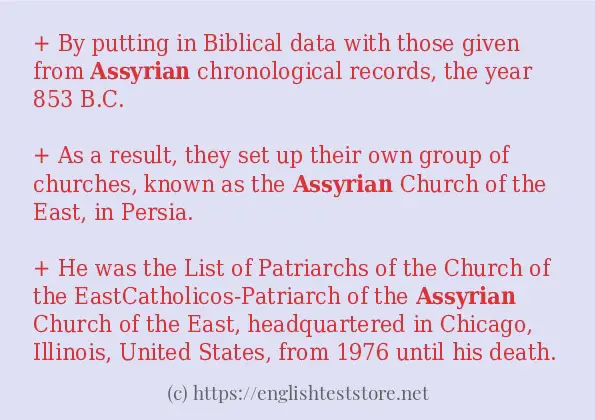How to use in-sentence of “assyrian”:
+ By putting in Biblical data with those given from Assyrian chronological records, the year 853 B.C.
+ As a result, they set up their own group of churches, known as the Assyrian Church of the East, in Persia.
+ He was the List of Patriarchs of the Church of the EastCatholicos-Patriarch of the Assyrian Church of the East, headquartered in Chicago, Illinois, United States, from 1976 until his death.
+ Major territorial states were the Akkadian kingdom, the Third Dynasty of Ur, and the Assyrian Empire.
+ Nahum wrote about the final destruction of Nineveh, the capital of the great Assyrian empire.
+ Babylon threw off the Assyrian rule in 612 BCE and became the capital of the Neo-Babylonian Chaldean Empire.
+ Scholars have placed the number of Assyrian victims from 300,000-750,000.
+ The Assyrian Church of the East also called Holy Apostolic Catholic Assyrian Church of the East is a ChristianityChristian church.

Example sentences of “assyrian”:
+ In the Assyrian period, the Armenian people of Nairi formed the kingdom of Ararat.
+ Tukulti-Ninurta II in 891 BC succeeded Adad-nirari II and expanded into Asia Minor and the Zagros Mountains, before being succeeded by Ashurnasirpal II in 883 BC, who recovered much of the territory lost after the fall of the Middle Assyrian Empire in 1100 BC, and ended an uprising caused by the Lullibi and Gutian people.
+ In the Assyrian period, the Armenian people of Nairi formed the kingdom of Ararat.
+ Tukulti-Ninurta II in 891 BC succeeded Adad-nirari II and expanded into Asia Minor and the Zagros Mountains, before being succeeded by Ashurnasirpal II in 883 BC, who recovered much of the territory lost after the fall of the Middle Assyrian Empire in 1100 BC, and ended an uprising caused by the Lullibi and Gutian people.
+ In the later overthrow of the Assyrian Empire, the Babylonians saw another example of divine vengeance.
+ In addition, he and his successors conquered areas previously only somewhat under Assyrian control, and Deportationdeporting Arameans and Hurrians.
+ It was the capital and a major city of the Assyrian empire.
+ Nineveh was an ancient Assyrian peopleAssyrian city on the eastern side of the Tigris River.
+ Assyrian peopleAssyrians were once a large ethnic minority in the Ottoman Empire, but following the early 20th century Assyrian Genocide, many were murdered, deported, or ended up emigrating.
+ The book ends with a song about the soon destruction of Nineveh and the death of the Assyrian people and end of the once great Assyrian rulers.
+ Nineveh was the capital city of the Assyrian empire.
+ Wheat helped the growth of city-states in the Fertile Crescent, including the Babylonian, Assyrian and persian empires.
+ The Assyrian were ruled by Sardanapalus, king of Nineveh.
+ That are especially five families of churches: the Assyrian Church of the East, the Eastern Orthodox Churches, Oriental Orthodoxy, the Eastern Catholic Churches, and Eastern Protestant Christianity.
